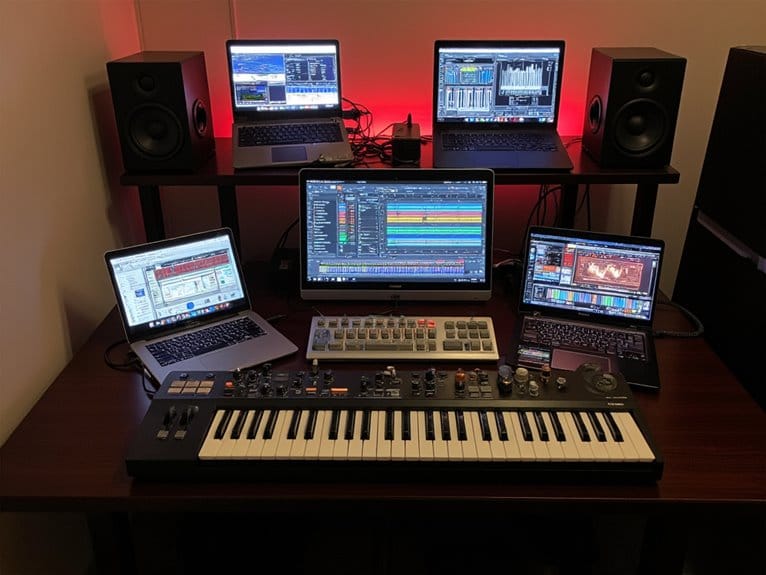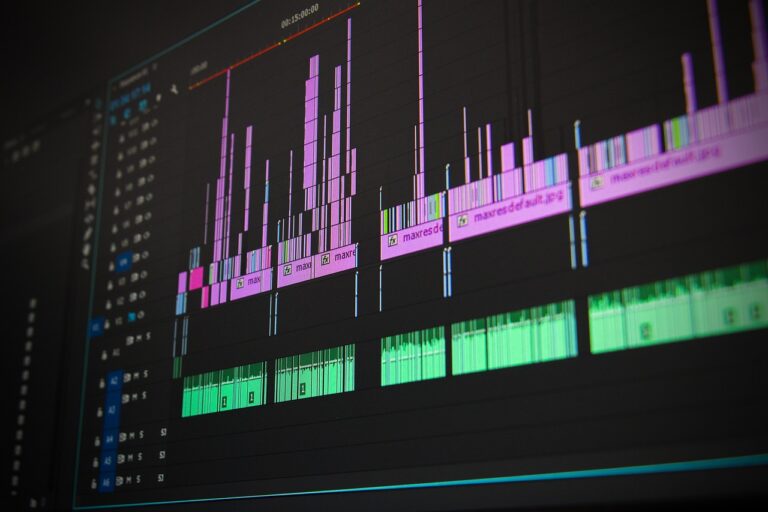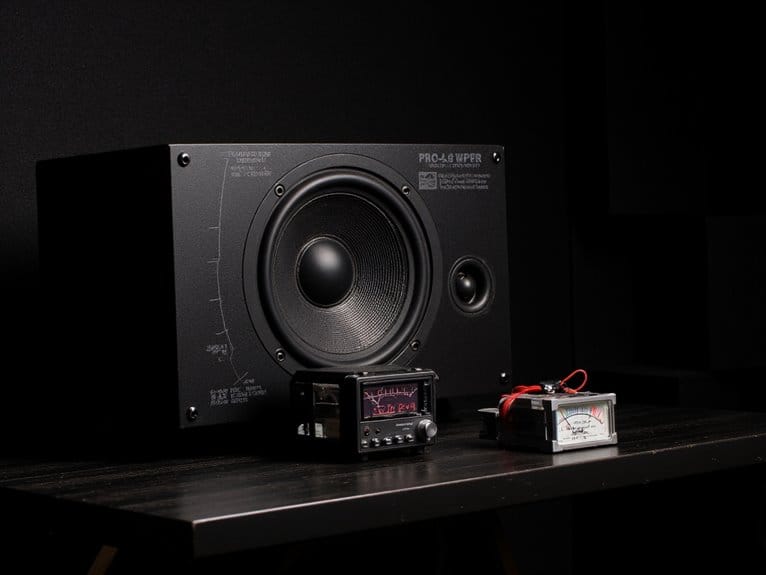Where Should the Compressor Go in the Chain?
When deciding where to place a compressor in the signal chain, there's no one-size-fits-all solution. It depends on the instrument, genre, and desired sound. Compressor placement before EQ can tame problematic frequencies, while placing it after EQ allows for precise tone shaping. Experimenting with different chain orders can yield surprising results. Boosting a signal with compression can add depth, but overdoing it can lead to a lifeless sound. With overdrive and distortion, placement can drastically alter the character of guitar dynamics. The key is to find the sweet spot where tone meets control. But that's just the tip of the iceberg…
We are supported by our audience. When you purchase through links on our site, we may earn an affiliate commission, at no extra cost for you. Learn more.
Compressor Before EQ: Why Not?
In the quest for ideal signal flow, placing a compressor before an equalizer (EQ) is often viewed as an unconventional approach, yet it can yield surprisingly effective results in taming problematic frequencies. By positioning the compressor before the EQ, you can rein in those pesky frequencies before they become exacerbated by the EQ's boosts or cuts. This chain order is particularly useful when working with dynamic compressor types, such as peak limiters or transient shapers, which excel at controlling sudden spikes in volume. By addressing these issues upfront, you can create a more balanced signal that's better suited for EQ adjustments, ultimately resulting in a more polished and refined sound. So, don't be afraid to flip the script and try the compressor before EQ – your mixes might just thank you.
Boosting Signal With Compression
Every so often, compression is used not to rein in a signal, but to boost it, a counterintuitive technique that can add depth, dimension, and character to an otherwise lackluster sound. By setting the signal threshold low and the ratio high, you can bring up the level of quieter parts, effectively "squashing" the dynamic range. This can be particularly effective on drums, bass, and vocals, where a more consistent level can add weight and authority. Just be careful not to overdo it, or you'll end up with a lifeless, pumped-up sound. When done tastefully, however, compression can be a powerful tool for adding size and swagger to your mix.
EQ Before Compression: The Rationale
By addressing tonal imbalances before compression, you can guarantee that your compressor is responding to the desired frequency range, rather than being misled by problematic resonances or deficiencies. EQ before compression allows for precise tone shaping, ensuring that your dynamic control isn't compromised by an uneven frequency response. By correcting tonal issues upfront, you can focus on achieving ideal dynamic control, rather than fighting fires caused by an unbalanced tone. This approach enables your compressor to work more efficiently, allowing you to achieve a more polished sound with greater ease. By prioritizing tone shaping, you'll be rewarded with a more cohesive and professional-sounding mix that achieves the perfect dynamic control.
Taming Frequencies With Compression
With compression, you can surgically excise problematic frequency ranges, allowing your tracks to breathe and your mixes to shine. By targeting specific frequencies, you can control the dynamics of your sound, reining in wayward peaks and taming unruly resonance. This frequency control is particularly useful when dealing with boomy kick drums, boxy guitars, or nasal vocals. By applying compression to specific frequency ranges, you can carve out space in the mix, creating a more balanced and polished sound. Dynamics shaping is key here, as you're not just reducing the overall level, but rather, reshaping the tone and character of the sound. With precision compression, you can refine your tracks, making them more cohesive and engaging.
Overdrive and Distortion Placement
Dialing in the perfect amount of grit, overdrive and distortion can add a layer of emotional intensity to your tracks, transforming lackluster sounds into fiery, attention-grabbing performances. In terms of drive tones, the placement of overdrive and distortion pedals in your signal chain can drastically alter the character of your guitar dynamics. Typically, placing overdrive pedals before the compressor allows the compressor to even out the dynamics, creating a more sustained tone. However, placing distortion pedals after the compressor can result in a more aggressive, crunchy sound. Experiment with different pedal orders to find the perfect balance of grit and control for your tracks. Remember, the key is to find the sweet spot where your tone is both fiery and focused.
Compressor After Overdrive: Benefits
Placing the compressor after overdrive and distortion pedals can have a profound impact on your tone, allowing the compressor to reign in the chaos and loose a more refined, articulate sound. By taming the aggressive peaks and valleys created by overdrive and distortion, the compressor can help even out your dynamic tone, making it more polished and radio-friendly. This placement also allows for subtle sustain, as the compressor can gently grip the note, prolonging its decay without suffocating it. The result is a tone that's both aggressive and refined, perfect for players who want to add a touch of sophistication to their heavy riffs.
Parallel Compression Techniques
In a clever twist on traditional compression techniques, parallel compression allows you to blend a heavily compressed duplicate of your signal with the original, untouched sound, effectively creating a tone that's both dynamically controlled and explosively vibrant.
Here are some key benefits of parallel compression:
- Smart routing: Send your signal to multiple compressors, each with different settings, to create a unique tone.
- Gain control: Balance the levels of your compressed and uncompressed signals to achieve the perfect blend.
- Tonal flexibility: Experiment with different compression styles, from subtle to extreme, to find the perfect fit.
- Dynamic range: Control the loudness of your signal while maintaining its natural dynamics.
- Creative freedom: Parallel compression opens up new possibilities for sound design and tone shaping.
Serial Compression in the Chain
By inserting multiple compressors in series, each stage carefully calibrated to tackle specific aspects of the signal, you can craft a meticulously refined tone that's as nuanced as it is powerful. This serial compression approach allows you to address different compression types, from gentle peak limiting to aggressive squash, in a specific chain order. For instance, you might start with an optical compressor to tame the signal's dynamic range, followed by a VCA compressor to add punch and definition. By carefully selecting and ordering your compression stages, you can create a tone that's both balanced and bold. Just remember to mind your gain levels and adjust accordingly to avoid an overly squashed sound.
The Importance of Gain Staging
Frequently, the Achilles' heel of an otherwise well-crafted compression chain lies in improper gain staging, which can lead to a tone that's either too squashed or too lifeless. A well-balanced gain structure is vital to achieving the perfect compression. When setting up your gain structure, remember:
- The ideal gain structure varies depending on the instrument, genre, and desired tone.
- A good rule of thumb is to aim for an average signal level around -18 dB to -12 dB.
- Be mindful of the dynamic range, as excessive peaks can lead to an uneven tone.
- Don't be afraid to adjust gain levels throughout the chain to optimize compression performance.
- Always keep an eye on your meters to verify you're not clipping or losing valuable headroom.
Experimenting With Compressor Placement
Every compressor chain is a delicate ecosystem, and the strategic placement of each compressor can drastically alter the tone, texture, and overall dynamics of your audio signal. Experimenting with compressor placement can uncover unique sonic characteristics, but it requires a deep understanding of compressor nuances. Chain experimentation is key to finding the perfect balance of compression and tone. Try placing a compressor before a distortion pedal to even out the signal, or after a EQ to glue the frequency response together. Don't be afraid to get creative and push the boundaries of traditional compressor placement. Remember, the goal is to refine the music, not to simply follow the rules. By embracing experimentation, you'll discover new sonic possibilities and take your mixes to the next level.






